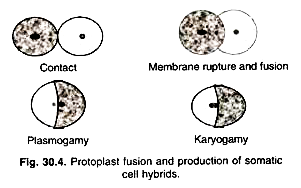In this article we will discuss about the structure of chlamydomonas with the help of suitable diagrams.
Chlamydomonas is unicellular, motile green algae. The thallus is represented by a single cell. It is about 20 p,-30|i in length and 20 µ in diameter. The shape of thallus can be oval, spherical, oblong, ellipsoidal or pyriform. The pyriform or pear shaped thalli are common, they have narrow anterior end and a broad posterior end (Fig. 1).
The structure of thallus can be divided into following parts:
(i) Cell Wall:
The cell is surrounded by a smooth, thin and firm cell wall made of cellulose. The cell wall at the anterior end is extended to make apical papilla. In some species the outer pectose layer dissolves in water medium to make gelatinous layer outer to cell wall.
The detailed structure of cell wall shows that it is multilayered and is made of cellulose fibrils. Inner to the wall lies the plasma lemma (plasma membrane). It is made of two membranes separated by an opaque zone.
(ii) Cytoplasm:
The cytoplasm is present in thallus between the cell wall and the chloroplast. The cytoplasmic structure includes the nucleus, mitochondria, endoplasmic reticulum, dictyosomes, ribosomes etc. The thallus contains single large, dark nucleus lying inside the cavity of the cup shaped chloroplast. The dictyosomes or Golgi bodies are found near the nucleus and they do not possess large vesicles.
Each cell contains two contractile vacuoles located at the base of flagella in a plane at right angle to them. The contractile vacuoles are excretory or osmoregulatory in function. They regulate the water contents of the cell by the process of osmosis. The thallus contains 80S ribosomes while 70S ribosomes characteristic of prokaryotic cells are present in chloroplast (Fig. 2).
(iii) Flagella:
The anterior part of thallus bears two flagella. Both the flagella are whiplash or acronematic type, equal in size. The flagella are mostly longer than the thallus but in some species they can be equal or shorter than the thallus. Each flagellum originates from a basal granule or blepharoplast and comes out through a fine canal in cell wall.
(iv) Neuro-Motor Apparatus:
In some species of Chlamydomonas e.g., C. nasuta, a sensitive neuro-motor apparatus is present. It controls movement of thallus in response to light, chemical and other stimuli.
The neuro-motor apparatus consists of two basal granules or blepharoplasts from which the flagella originate, a transverse cytoplasmic fibre paradesmos which connects two blepheroplasts, a cytoplasmic fibre rhizoplast connecting one blepheroplast with the centrosome and a small delicate fibre connecting centrosome with nucleolus (Fig. 2, 3).
(v) Chloroplast:
In Chlamydomonas generally a large, cup shaped parietal chloroplast is present in cytoplasm (Fig. 4A). But the chloroplasts can be of various shapes in different Chlamydomonas species (Fig. 4B, C).
The chloroplast is ‘H’ shaped in C. bicilliata, reticulate in C. reticulata, parietal in C. mucicola stellate in C. arachne and axile in C. steinii, the chloroplast is generally associated with pyrenoid covered with starch plates, but sometimes pyrenoids can be more than one. The pyrenoids are two in C. debaryana and many in C. gigantae.
The pyrenoids are concerned with synthesis of starch. In chloroplast there are 2-6 thylakods which join to form a granum.
(vi) Stigma or Eyespot:
The anterior side of the chloroplast contains a tiny spot of orange or reddish colour called stigma or eyespot. It is photoreceptive organ concerned with the direction of the movement of flagella. The eye spot is made of curved pigmented plate. The plate contains 2-3 parallel rows of droplets or granules containing carotenoids (Fig. 5).



